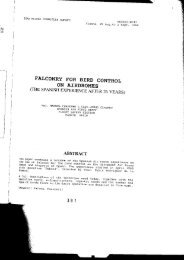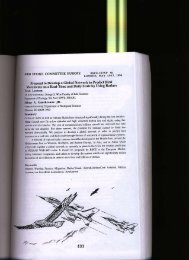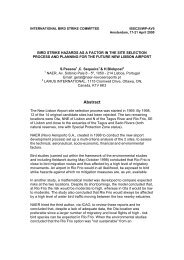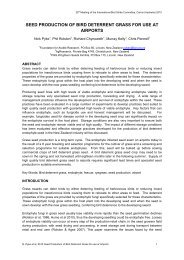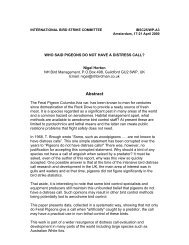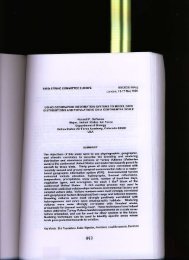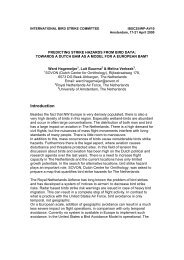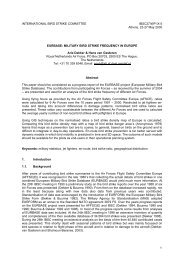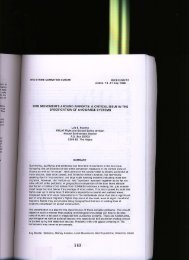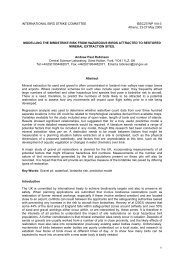Standards for aerodrome bird/wildlife control - International Bird ...
Standards for aerodrome bird/wildlife control - International Bird ...
Standards for aerodrome bird/wildlife control - International Bird ...
Create successful ePaper yourself
Turn your PDF publications into a flip-book with our unique Google optimized e-Paper software.
3. Organisation<br />
Background<br />
Different <strong>aerodrome</strong>s adopt a variety of organisational structures <strong>for</strong> their <strong>bird</strong>/<strong>wildlife</strong><br />
<strong>control</strong> programmes. These vary from having <strong>bird</strong> <strong>control</strong> as a secondary duty of the<br />
Air Traffic Control or Fire Sections, through staffing <strong>bird</strong> <strong>control</strong> from the Airfield<br />
Operations Section to employing specialist <strong>wildlife</strong> managers or <strong>bird</strong> <strong>control</strong> units.<br />
<strong>Bird</strong> <strong>control</strong> staffed from larger units has the advantage that there are more staff to<br />
call upon and greater flexibility to cope with sudden increases in <strong>bird</strong> numbers.<br />
However, staff employed primarily in other roles may regard <strong>bird</strong> <strong>control</strong> as a<br />
secondary or low status duty which, if they only carry it out on rare occasions, it not<br />
really their personal responsibility. Conversely, small specialist units are normally<br />
staffed by people who have a real interest in <strong>bird</strong>s and <strong>bird</strong> <strong>control</strong>, and who clearly<br />
recognise that the responsibility <strong>for</strong> <strong>bird</strong>s on the airfield lies with them. This<br />
‘ownership’ of the <strong>bird</strong> problem can be a powerful motivation to improve standards of<br />
<strong>bird</strong> <strong>control</strong>. Such units may, however, find it difficult to cope with staff illness or<br />
sudden increases in <strong>bird</strong> numbers which require additional staff to be deployed.<br />
Whichever organisational system is in place, it should deliver the standards<br />
described elsewhere in this document.<br />
Collaboration and coordination between organisations on the airport<br />
Communication between the various interested gropus and organisations on an<br />
airport is essential if good <strong>bird</strong>/<strong>wildlife</strong> <strong>control</strong> standards are to be achieved. Airfield<br />
Operations, Grounds Maintenance, Air Traffic Control, Airport Fire Service, Airport<br />
Planners, Airlines etc. All have a role to play in identifying and correcting problems<br />
that may occur. Airport management should ensure that a mechanism is available<br />
(e.g. an airport <strong>bird</strong>strike prevention committee) which enables these organisations to<br />
participate in the <strong>bird</strong>/<strong>wildlife</strong> hazard management process. This will help to ensure<br />
that these organisations<br />
4. Equipment<br />
Background<br />
The type and level of sophistication of the equipment needed to deter <strong>bird</strong>s/<strong>wildlife</strong><br />
from airfields depends on the species involved and the quantity of manpower that<br />
can be deployed. If a single staff member is required to disperse <strong>bird</strong>s/<strong>wildlife</strong> from a<br />
large airport then equipment such as pistol launched pyrotechnics or distress call<br />
broadcasting devices will be essential. If more staff can be deployed or is the airport<br />
is small, then more basic equipment may suffice.<br />
<strong>Bird</strong>/<strong>wildlife</strong> deterrent devices can be broadly divided into visual, acoustic and lethal,<br />
and subdivided into portable and static systems. The levels of sophistication, and<br />
hence cost, available are highly variable and include the simple scarecrow, (a static<br />
visual device), complex radio <strong>control</strong>led sound grenerators (static acoustic),<br />
pyrotechnic pistols and vehicle mounted distress call apparatus (mobile acoustic),<br />
hand held lasers (mobile visual), traps (static lethal) and a shotgun (mobile lethal).<br />
The choice of which systems, or combination of systems, to deploy will depend on<br />
cost, legal and logistical constraints and, perhaps most importantly, on the species<br />
10



